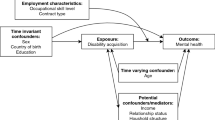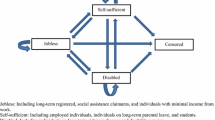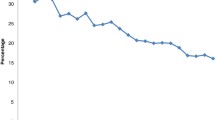Abstract
The relationship between employment and disability has gained national attention, as the ability to maintain employment is inconsistent among those with limitations. This cross-sectional study of employment among individuals (N= 1691, age 21–62 years) with self-reported limitations in the 1996 Medical Expenditures Panel Survey seeks to identify predictors of employment despite physical and/or cognitive limitations. Two predictive models of employment including 10 variables are explored; 1 included insurance (χ2 =3856.85, p ≤ 0.00) and the other removed the insurance variable (χ2 =280.21, p ≤ 0.00). Individuals with limitations who are employed are more likely to have a college-level education, have better physical and mental health perceptions and have private insurance. This analysis demonstrates that people do work despite reported activity, functional or sensory limitations and that socioeconomic factors are crucial in why someone is able to attain employment.
Similar content being viewed by others
REFERENCES
General Accounting Office. Welfare Reform: Former TANF Recipients With Impairments Less Likely to be Employed and More Likely to Receive Federal Supports, GAO-03-210. Washington, DC: U.S. General Accounting Office, December 2002.
Social Security Administration. Annual Statistical Annual Statistical Report on the Social Security Disability Insurance Program, 2000. Retrieved January 2, 2003 from http://www.ssa.gov/notices/supplemental-security-income/
Franche, R-L, Krause, N. Readiness for return to work following injury of illness: Conceptualizing the interpersonal impact of health care, workplace, and insurance factors. J Occupational Rehabil 2002; 12: 233-256.
Fauerbach, JA, Engrav, L, Kowalske, K, Brych, S, Bryant, A, Lawrence, J, Li, G, Munster, A, de Lateur, B. Barriers to employment among working-aged patients with major burn injury. J Burn Care Rehabil 2001; 22: 26-34.
Tanttula, K, Vuola, J, Asko-Seljavaara, S. Return to employment after burn. Burns 1997; 23: 341-344.
Keyser-Marcus, LA, Bricout, JC, Wehman, P, Campbell, LR, Cifu, DX, Englander, J, High, W, Zafonte,, RD. Acute predictors of return to employment after traumatic brain injury: A longitudinal follow-up. Arch Phys Med Rehabil 2002; 83: 635-641.
Yelin, E. The earnings, income, and assets of persons aged 51-61 with and without musculoskeletal conditions. J Rheumatol 1997; 24: 2024-2030.
Ahlgren, C, Hammarstrom, A. Has increased focus on vocational rehabilitation led to an increase in young employees' return to work after work-related disorders? Scand J Public Health 1999; 27: 220-227.
Hennessy, J, Muller, S. Work efforts of disabled-worker beneficiaries: Preliminary findings from the new beneficiary follow up survey. Soc Secur Bull 1994; 57: 42-51.
Turner, JA, Franklin, G, Turk, DC. Predictors of chronic disability in injured workers: A systematic literature synthesis. Am J Ind Med 2000; 38: 707-722.
Feuerstein, M, Menz, L, Zastowny, T, Barron, B. Chronic back pain and work disability: vocational outcomes following multidisciplinary rehabilitation. J Occup Rehabil 1994; 4: 229-250.
Teassel, RW, Bombardier, C. Employment-related factors in chronic pain and chronic pain disability. Clin J Pain 2001; 17: S39-S45.
Curtis, P. A back-to-work strategy can protect your benefits. Positive Living. 1999; 8(2): 39, 35.
James, J. Disability benefits: New law will help disabled return to work. AIDS Treat News 2000; 334: 7-8.
World Health Organization. International Classification of Functioning, Disability, and Health. ICF, Geneva: WHO, 2001.
Mayfield, JA, Deb, P, Whitecotton, E. Work disability and diabetes. Diabetes Care 1999; 22: 1105-1109.
Department of Labor Employee Benefits Security Administration. Frequently Asked Questions About COBRA Continuation Health Coverage. Retrieved April 15, 2003 from http://www.dol.gov/ebsa/
Mitra, S, Brucker, D. (in press), The early intervention project: An innovative initiative to return Social Security applicants to work. J Disab Policy Stud.
Grzywacz, JG, Dooley, D. Good jobs to bad jobs: Replicated evidence of an employment continuum from two large surveys. Soc Sci Med 2003; 56: 1749-1760.
Author information
Authors and Affiliations
Corresponding author
Rights and permissions
About this article
Cite this article
Findley, P.A., Sambamoorthi, U. Employment and Disability: Evidence from the 1996 Medical Expenditures Panel Survey. J Occup Rehabil 14, 1–11 (2004). https://doi.org/10.1023/B:JOOR.0000015007.46881.84
Issue Date:
DOI: https://doi.org/10.1023/B:JOOR.0000015007.46881.84




